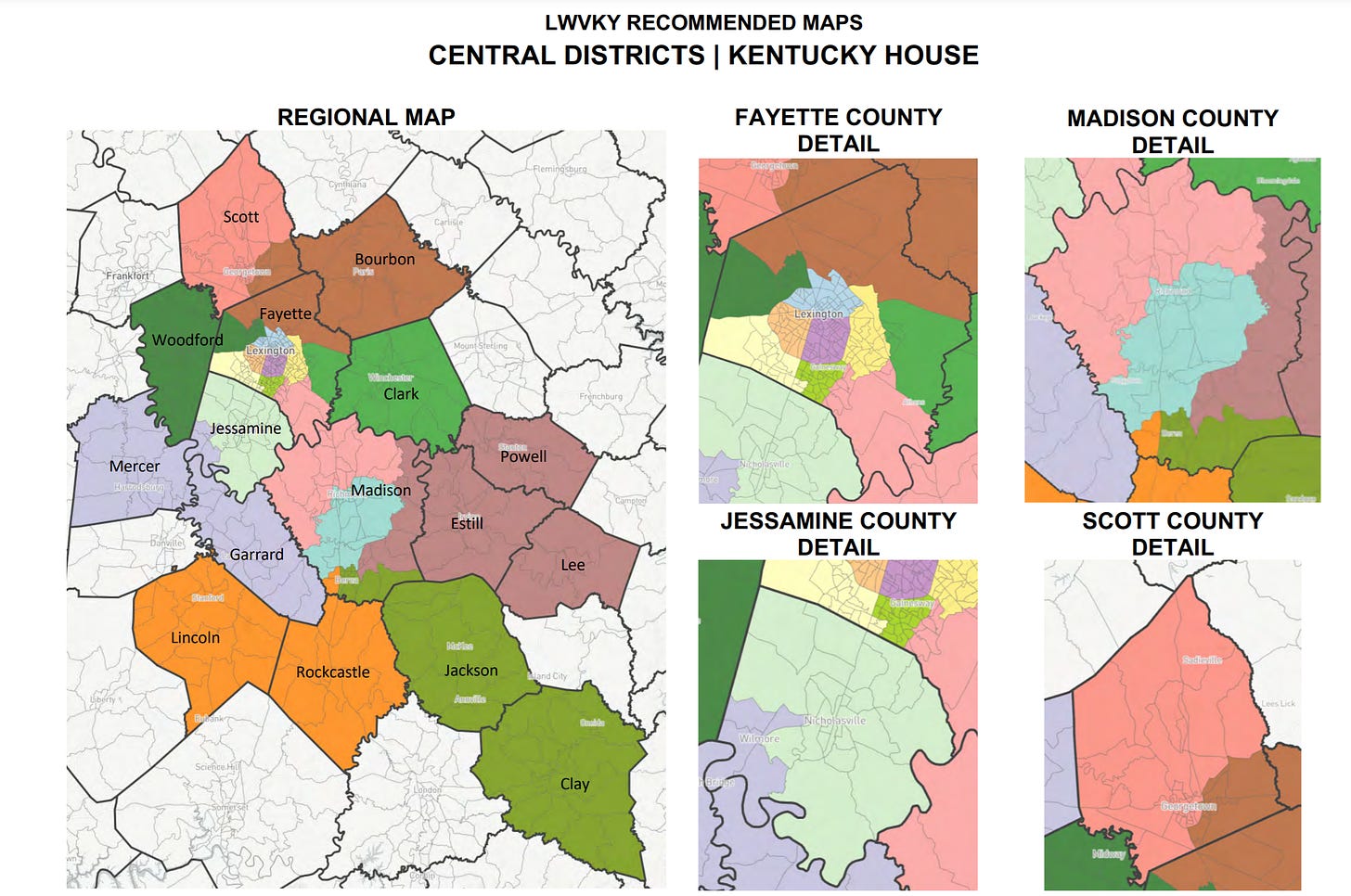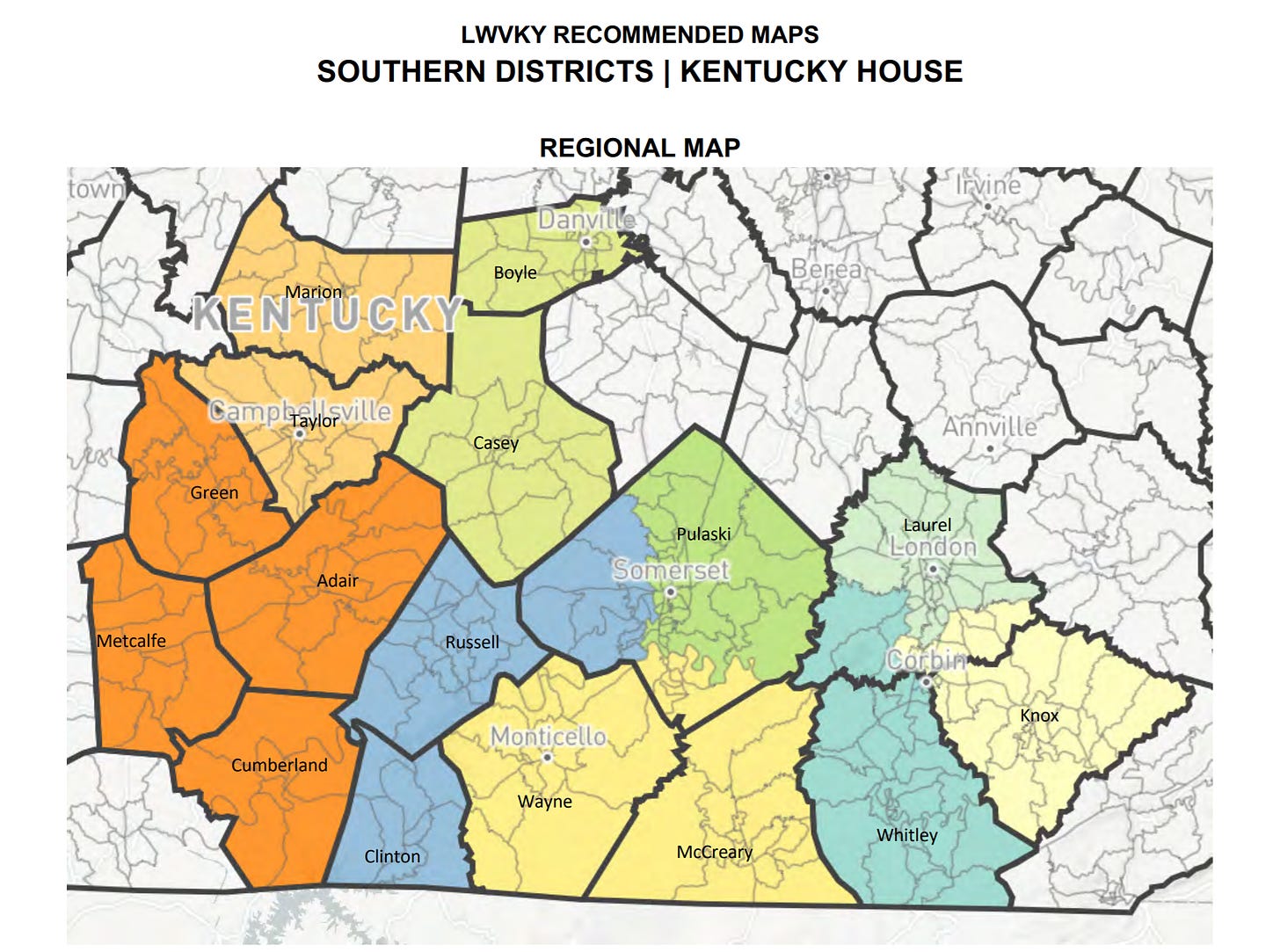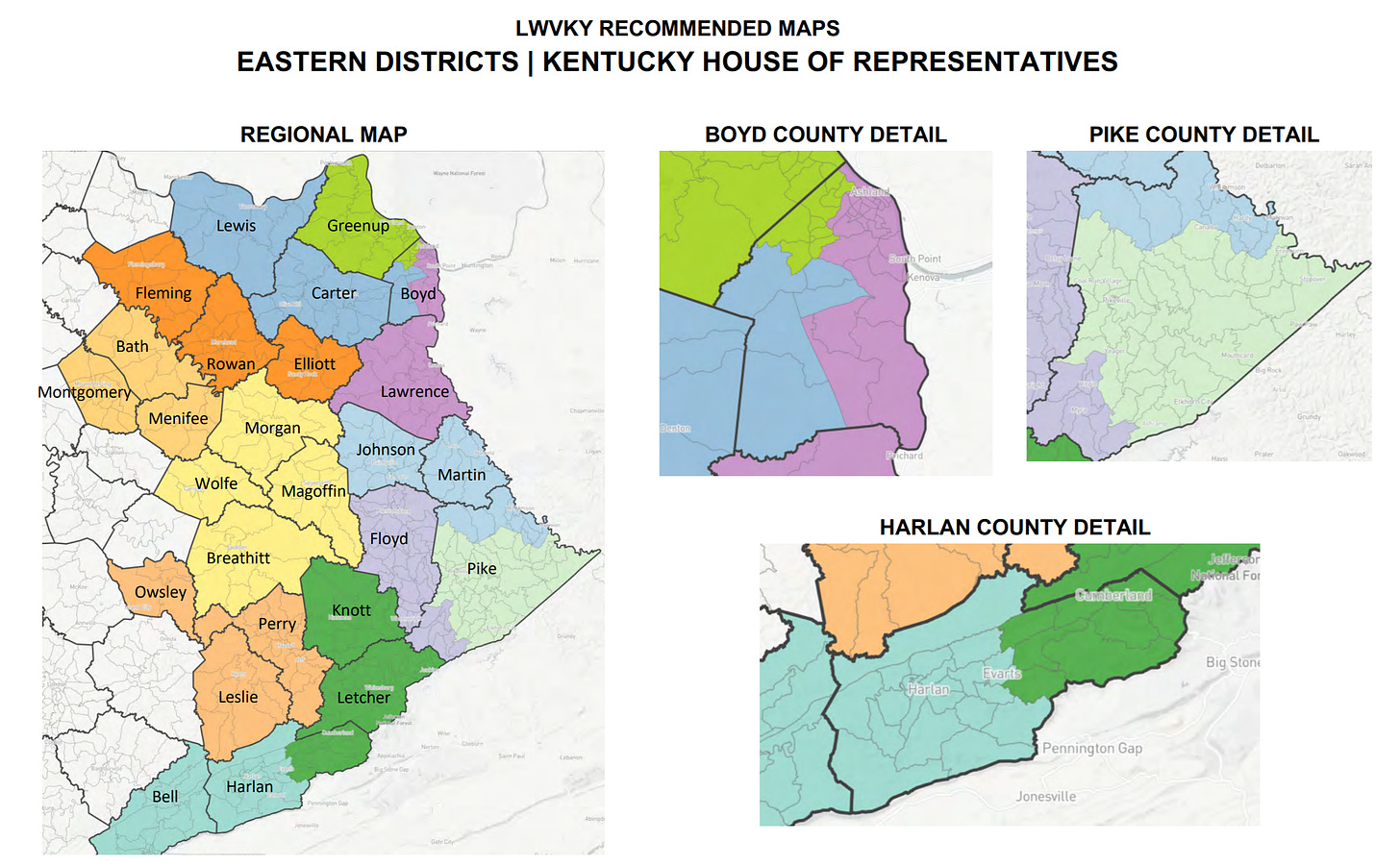“Everybody knows what gerrymandering is, but many people don't understand it's bad redistricting."
The League of Women Voters of Kentucky's Fair Maps Campaign pushes back on a legislator-dominated redistricting process that lacks transparency.
Few decisions have as much impact on how a city, state or country is molded as redistricting lines, shaping not only who is elected to represent the people in your neighborhood (and beyond) but every single decision they make on “your behalf” once arriving in legislative chambers. Occurring every ten years after the latest census data is released, the redistricting process—historically—often goes off the rails, whether that manifests as the people in charge not quite understanding how to do it correctly—as was Kentucky’s case after the 2010 census—or individuals conspiring to purposefully gerrymander districts to their own end. Or, you know, both.
Since this is such a monumental, once-in-a-decade decision, it would stand to reason that public input and transparency would be paramount: Citizen involvement! Listening tours! An independent commission!
But, ala, this is not the case.
Kentucky is one of 27 states that hands the redistricting process entirely over to the legislature, giving the party in charge an extraordinary amount of sway. This year’s redistricting map drawing—for the first time in recent memory—is controlled by Republican lawmakers, and while Governor Andy Beshear, a Democrat, could technically veto their map plan, the Republican supermajority stronghold means that an override is practically inevitable.
With time ticking down and the holiday season fast approaching, a special legislative session to address redistricting seems increasingly unlikely, meaning that when legislators return to work on January 4, they’ll have only three days to present their redistricting plan to peers and the public, leaving little room for feedback or change before the January 7 candidate filing deadline. (Can you imagine the headache if you were planning to run in one district, then discovered when going to file on January 7 that you now live in an entirely different district? Whew!)
(Click here to view the LWVKY recommended maps, an index of county populations/placements and links to interactive versions.)
If the redrawn maps are done correctly by legislators (and that’s a huge if), the worrisomely tight timeline will practically guarantee that most Kentuckians will be unaware of any changes that are made—changes that impact their daily lives—until it’s too late.
Legislators could provide draft maps at any juncture, showing their work and giving the people they represent at least a general idea about how they plan to address the latest population shifts, like declining population in far eastern Kentucky and a boom around Lexington’s collar counties. But instead, they’re working behind closed doors—maybe even under the cover of darkness? Who can say!—creating a redistricting map that will touch every life in the commonwealth without listening to feedback from those they represent.
But it doesn’t have to be this way.
For the past three years, the League of Women Voters of Kentucky (LWVKY)—a nonpartisan organization that “promotes the informed and active participation of citizens in government through study and action”—has worked tirelessly to advocate for, and educate about, the foundational importance of transparent redistricting, pushing for legislation that would create a more open process and launching the Fair Maps Campaign, a months-long effort to gather feedback from communities statewide about the redistricting maps that they’ve created as a recommendation for the legislature. LWVKY released their final recommended redistricting maps yesterday, a culmination of work that was out in the open from start to finish.
Below, I chat with LWVKY’s Dee Pregliasco about the Fair Maps Campaign, their dogged efforts to teach Kentuckians about the importance of redistricting, and how legislators in charge simply won’t budge on keeping the people they represents in the dark.
Curious how other states handle redistricting? Click here to read more about how a better way is not only possible in Kentucky—it’s already happening all across the country.
Dee Pregliasco, Vice President, League of Women Voters of Kentucky
Sarah Baird: How have the Fair Maps Campaign forums gone over in communities?
Dee Pregliasco: We’ve had forums in Morehead, Pikeville, Hopkinsville, Bowling Green, Louisville, Lexington and Northern Kentucky to educate people about what redistricting is, in addition to getting their input on the redistricting maps. I mean, everybody knows what gerrymandering is, but many people don’t understand that it is bad redistricting. Sometimes—depending on the group—I’ll start off by saying “You've heard the word gerrymandering.” They say, “Oh yeah.” And I’ll say, “Well, so what about redistricting? You know that word?” And a lot of people don't. They have not really connected the two. So when I say that gerrymandering is bad redistricting, they go, “Oh!” We wanted to educate people about the process with the forums.
At our final forum, which was statewide [and online], we had a lot of great questions for our map expert, [Danville resident] Susan Perkins Weston, who is just a whiz on the computer with Maptitude, the same program that the legislature uses. She went over all of our draft maps, and then we got input from people. That's what we’ve wanted all throughout this process, because the legislature did not open it up. I mean, we know that they are right now drawing maps with no public input.
(Click here to view the LWVKY recommended maps, an index of county populations/placements and links to interactive versions.)
SB: What would it take for the redistricting process to become more transparent in Kentucky?
DP: Our constitution literally gives the power to the legislators [to redistrict], so to change that, it would take a constitutional amendment. What we pushed last year in the legislature, and this year in the legislature, were two bills that would set up an advisory commission. In order to get a constitutional amendment, that's a really big haul. With the time we had, we felt like we ought to push for this advisory commission. People would be appointed by the legislators or apply to be on the commission themselves. They would’ve gone all over the state to have hearings, and the bill was very detailed to make sure that it wasn’t full of politics.
Since that didn’t happen either year, we even had a joint resolution trying to get them to agree that they would open up the process to the public. That didn’t happen either, so that's when we decided to do these forums. In the meantime, all last year and this year, we have spoken to over 100 groups of people: chambers, rotaries, Kiwanis, church groups, civic groups—you name it.
So, what has the legislature said? We’ve been in communication—particularly with leadership, which is all Republican—and talked with them. We've shared our early maps with them. Using the old census data from 2010, we did maps, which were much simpler and fairer than what they had done previously, and then when the new [2020 Census] data came out, we redid them. Now with all of this input, we’re redoing them again and hope to have them out by December 1. [Ed. note: The final maps were released yesterday.]
A lot of communities are upset about the way the lines have been drawn in the past, and our mantra has been: We, the voters, should choose the representatives—they shouldn't choose us. And what we know is, in the past, Democrats and Republicans all across the country have been bad actors. And for probably 40 years in Kentucky, Democrats were doing it poorly. And now the Republicans are in charge and what I've said to them is, “You all can be revengeful, or you can be good government.”
They’ll say, “Why weren't you paying attention before?” And I say, “We should have been paying attention.” Everybody should have been paying attention. And we weren't, but just because we didn't do it in the past, doesn't mean we're going to continue to ignore it. Open the process. Have it be transparent. I always say it needs to not be done in a dark room in the basement of the Capitol.
SB: What are some recommendations you’ve made in your maps that differ from older versions?
DP: What we did was if you looked at the old State Senate map—in Eastern Kentucky, for example—there are these “strings of beads” that are long, ribbon-like groups of counties put together. And what we tried to do is make those more compact: more like a circle as opposed to a long ribbon. One of these districts right now [Senate District 14] goes from southeastern Jefferson County all the way through four counties, down to Casey County. So, here's Casey County—one of the poorer counties in the state—connected to Jefferson County.
This is all based on population numbers, so we have to deal with the numbers. But if you look at the current congressional map, you'll see how crazy it is because the First District goes all the way from the Mississippi River to touching Eastern Kentucky. Then a little bit of eastern Jefferson County is in the fourth district, which goes all the way over to Ashland on the border with West Virginia. That doesn’t make sense, right?
(Click here to view the LWVKY recommended maps, an index of county populations/placements and links to interactive versions.)
SB: What has been the response from legislators to your maps?
DP: What the legislators keep saying about their own maps is, “We're working on them.” They’ve seen our maps, and actually we’ve had some complaints because we did not pay any attention to incumbents. One of the Republican legislators said to me, “You even eliminated a couple of Democratic seats!” And I said, “So?” We did not pay attention to incumbents. We're non-partisan.
The House has been much more receptive, as far as House leadership goes, as opposed to the Senate. We haven't been able to get [Senate President Robert] Stivers or [Major Floor Leader Senator Damon] Thayer to talk to us at all.
I testified before the Joint Committee on State Government in July, and I tried to introduce myself to Senator Thayer afterwards. All he could say was, “Well, my constituents have elected me to do redistricting.” And, yes, we know you have the power—we just want you to open up the process.
They go back [for the regular legislative session] January 4, and one of them did say that they thought there would be some maps out before Christmas. But that's not exactly an easy time for people to have public comment—on purpose. We put our maps out as early as August. They could have certainly put out maps.
One of the pressures they have, too, is the January 7 filing deadline for office. There's no time in those three days between when they come back and the filing deadline to get public comment into whatever they've drawn. So, the question is, are they going to push that deadline back? We thought they would've done it last year or this year in the legislative session, but they didn't. Pushing it back just makes sense because people running for office need to know if their district is going to change, or if they’re going to have to maybe run in a different district. And they need to know that be before the filing deadline.
Unlike Las Vegas—what happens in Las Vegas stays there—what happens in Frankfort does not stay there. They pass laws that affect all of us. It affects our schools. It affects our health, our parks, our roads, businesses, regulation. I mean, it affects everything. And that's why part of what we do is try to get people civically engaged. Hey guys, we need to pay attention!
SB: What are some population trends you’ve noticed that will impact redistricting in rural Kentucky?
DP: Rural areas have some really special needs. By having lost population, those districts are going to have to be bigger, and so their power will be diluted. Part of that is just something that nobody’s been able to control in the sense of population loss, but with their power being diluted, what does that mean for what's going on in the legislature? What happens is it pits these communities against one another instead of working together. I mean, the urban-rural divide is a real issue. People in eastern Kentucky should be concerned about the western part of Louisville, and people in Louisville need to be concerned about eastern Kentucky—if we really are in this boat together as a state.
(Click here to view the Kentucky LWV recommended maps, an index of county population/placements and links to interactive versions.)
SB: What are you most concerned about happening during that first, impossibly rushed, week of January?
DP: Well, if they change the filing deadline, that could give them more time, but our biggest concern is that they put out their maps and say that they’re going to vote on them the next day or three days later.
Before the lawsuit in 2012, after the 2010 census, they did this. They drew the maps, and only had a few days to vote on them. They had done them incorrectly, so then lawsuits were filed. When they came back after the lawsuit to redo it, they did it in either five or seven days again. In other words, no lessons were learned. Why not take that time to get public input?
We do get questions about whether or not there are going to be lawsuits filed about this, and we don't know, because we don't know what the legislators are doing. For example, for the State Senate and State House, the population differential can’t be more than five percent either way. Are they going to abide by that? And, of course, they have to abide by federal equal protection law. And then there’s the Voting Rights Act. Are they going to do that correctly? We just don't know for sure. Will some of these eastern Kentucky counties that are going to be lopped together into bigger districts do something? It’s just hard to know because we don't know what their redistricting maps look like.
They know what our maps look like. Our cards are on the table.
This interview has been edited and condensed.
Unnerved that legislators are drawing maps without public input? Call yours up and tell them so! Seriously, it takes five minutes.
And if you’re looking for a way to help others this holiday season, give back directly to those in need in our region by supporting Eastern Kentucky Mutual Aid:








